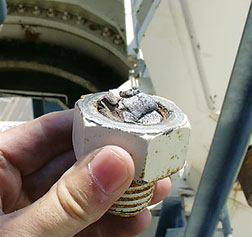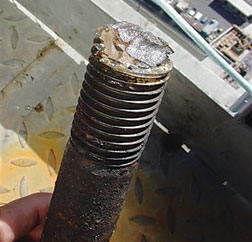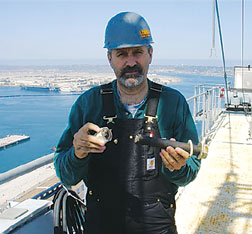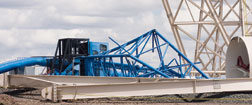... a weld in the crane’s turntable, which includes a large gear that allows the boom’s superstructure to rotate.
Slewing gears usually are about 8-ft in diameter and are fastened to the frame with as many as 120 bolts torqued beyond 1,000 ft-lb, experts say. Operators often pass through the ring before climbing into the cab. Other turntable members are bolted and welded. The bolts have a strength rating and lifespan prescribed by manufacturers and can be untorqued and retorqued a specific number of times.
Missed Signal
 Terry Mcgettigan/Tower Crane Support LLC
|
 Terry Mcgettigan/Tower Crane Support LLC
|
 Terry Mcgettigan/Tower Crane Support LLC McGettigan holds broken slew bolt, extracted on May 30.
|
Observers say they don’t understand why a weld broke without warning. “That thing didn’t just flop off the top of the tower,” says Jeff York, a licensed crane inspector and president of Hayward, Calif.-based Signal-Rite LLC. “There was some warning given; somebody just didn’t see the signal.”
Cranes, like many cantilevered steel structures, are prone to fatigue under cycle-loading, adds Gene Corley, senior vice president of Skokie, Ill.-based forensic engineer CTLGroup. Corley says he is investigating another accident in which structural fatigue, apparently missed in inspections, was a contributor. A crack, found near the tower’s base, “should have been repaired, and evidently the inspection missed the problem,” he says.
The Kodiak weld was part of a recent repair made to the rotator, sources say. Manufacturers usually require such fixes to be performed by a certified welder. Exactly what happened to the turntable is still uncertain, says the owner of both Manhattan cranes that collapsed this year, James F. Lomma. The crane-rental operator says he is “upset about the whole thing” and has not yet had a chance to review the maintenance logs for himself. But Lomma notes that his fleet of roughly 275 mobile and tower cranes receive three inspections under each rental contract and another routine inspection once a year by a consultant, at Lomma’s expense in a company yard.
As with the March accident, criminal investigators now are searching for answers as to why the Kodiak fell, and they have subpoenaed records of the vintage rig, which Lomma says was built “sometime” in the early 1980s. Building officials ordered all four other Kodiaks working in New York City to be re-inspected and are reviewing their maintenance logs.
Kodiak cranes, built domestically but no longer in production, are similar to Malaysia-made Favelle Favco cranes in their fast line speeds. New York City’s March accident involved a Favco 440, with capacity of 50 tonnes at 10 meters. These Kodiak and Favco cranes are powered by a diesel engine, a peculiarity among the dominant electric tower cranes, but prove a strength in production speed, often outpacing electrics by two, three or four to one, experts say.
If repairs made to the turntable turn out to be faulty, then “that certainly shifts the spotlight away from Jimmy Lomma and more to the intricate practices of crane repair,” says Graham J. Brent, executive director of the Fairfax, Va.-based National Commission for the Certification of Crane Operators, which writes standardized tests for operators. It is working on new tests for riggers, signal persons and inspectors, adds Brent.
|
More Cranes, More Accidents?
Crane accidents have increased 104% in the U.S. and 44% globally, over the same period last year. |
Lomma, the 61-year-old president of Maspeth, N.Y.-based New York Crane & Equipment Corp. and South Kearny, N.J.-based heavy-hauling and rigging outfit J.F. Lomma Inc., says a crane’s age does not necessarily make it unsafe. “Some of the cranes out there are 20, 30 40 years old, and they’re still operating,” he says, adding, “I’m sure they are safe as long as the inspections are done properly.” But Lomma says he would like to see inspection requirements improve. “OSHA rules are 40 years old. City rules are 40 years old. They’re old,” he says.
The risk around cranes is huge. Tower cranes used on high-rise buildings can cost up to $4 million to replace and rent for $30,000 to $50,000 per month, and their value has spiked in recent years under global demand. About 3,000 tower cranes work in the U.S. and more than 100,000 are elsewhere, many of them in China, says Stuart Anderson of Hagerstown, Md.-based analyst Chortsey Barr Associates. Others believe demand has tripled in the last 10 years.
| ||||||||||||||||||||||||
In New York City, Lomma rents tower cranes to concrete contractors “bare,” or without an operator, for liability reasons, while steel erectors typically own and operate their own cranes. Lomma says he requires clients to carry $5 million in general liability insurance and $1 million in workers’ compensation insurance. March’s midtown accident could cost up to $200 million in damages, sources say.
Because of these risk factors, crane regulations are under heavy scrutiny. Locally, a panel of about 80 construction officials and regulators in New York City convened an emergency meeting on May 31, according to Louis Coletti, president and chief executive of the Building Trades Employers’ Association. “You can’t do things the same way you’ve done them for 20 years,” he says. “There are new technologies, new equipment, new construction means and methods.”
Around the country, people are studying the risks. Operators whose workstations fly high above the jobsite are particularly skittish, afraid that training on the ground is not being well addressed. “It’s spooky,” says Terry McGettigan, a 53-year-old operator in San Diego who has worked with cranes for 32 years. “I want to get the hell out of the seat. People are taking procedures and tweaking them for their own liking. I don’t like what some crews are doing. Manufacturers’ procedures are not being followed to the tee.”
The party responsible for inspection is a big question. Operators have little time to inspect, says McGettigan, who notes that California requires licensed, third-party inspections twice a year and each time a crane is put into service. California initiated this rule in 1992 after a deadly 1989 tower-crane collapse in San Francisco. No other state or local government has such stringent inspections, except for cranes employed for maritime uses or the Dept. of Defense, experts say. Washington state has a similar rule slated to go into effect on Jan. 1, 2010, spurred by a deadly tower-crane collapse in Bellevue in 2006, Brent notes.
 AP/Wideworld Collapse at Wyoming mine on May 31 took out a giant crawler.
|
After the latest New York accident, McGettigan on May 30 climbed the Terex tower crane he was operating in San Diego. Worried about his slewing ring, he found a loose bolt after he tapped it with a 2-lb hammer. Another bolt sheared clean off after he gave it “a decent whack,” he says. Then he pulled out the loose bolt and found a crack. “I said, ‘The only thing that is going to satisfy me is having a Terex engineer evaluate this.’” The job was shut down.
Some inspectors and operators are prepared, and others are not, to prevent accidents related to bearing failure or fatigue on inner welds, says Dennis O’Rourke of National Crane Services, Orlando, and president of the Crane Certification Association of America, Vancouver, Wash. “There are a lot of components on all types of cranes that do not lend themselves to visual inspections because they are not visible and disassembly is required,” he says.
Owners should develop procedures and data practices, adds O’Rourke, noting the American Petroleum Institute’s requirement to disassemble and inspect hook blocks every five years.
Texas led the U.S. in crane-related fatalities in 2005-06, according to the Labor Dept. “All crane accidents I’ve been involved with or researched were avoidable,” says Mark Bakeman, a former crane operator in the state. You got these cowboys who think, ‘I’m 10,000 lb out of chart, but I know the crane will do it.’”
Within hours of the Kodiak affair, Washington, D.C., officials called for inspection of 40 licensed cranes there. Inspectors spent the next week sweeping construction sites to check permits and safety records. The local Dept. of Consumer and Regulatory Affairs also requires contractors to hire third-party inspectors for safety checks.
Maryland’s Occupational Safety and Health agency is pushing for rules that could lead to new procedures and certification of crane operators. The agency began looking into the issue last year when Ron DeJulius, a former crane operator, took over as commissioner. This spring, the agency’s 52 inspectors were asked to complete additional training.
At the federal level, sources say OSHA’s new standard for crane and derricks should be ready for comment by the end of the summer. The result is expected to look similar to an industry consensus reached in 2004 that calls for operator certification as well as daily, monthly and annual inspections by a “qualified” person but falls short of calling for independent, certified inspections.
Brent says the forthcoming Washington state standard, which incorporates the 2004 OSHA consensus language but requires the additional step of third-party inspection, is the most comprehensive rule he has seen. But he adds that California’s rule is not to be discounted. “You absolutely would not want to develop something else without at least looking at both of them,” Brent says.


Post a comment to this article
Report Abusive Comment